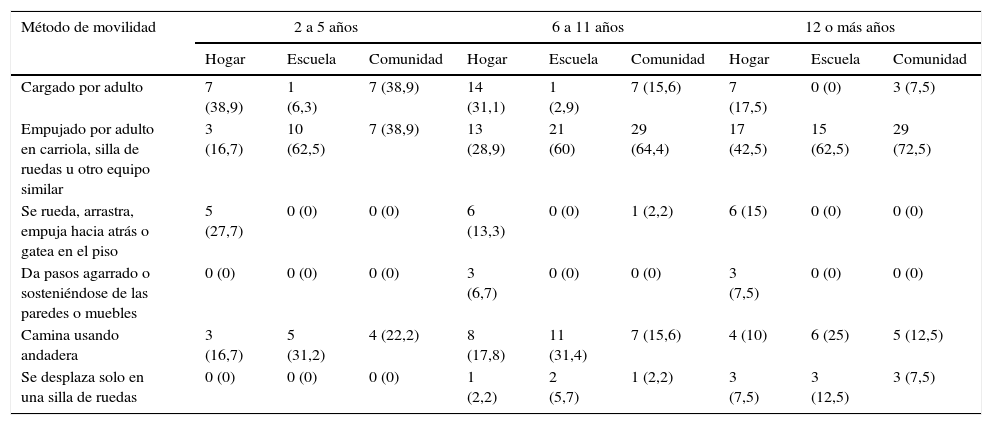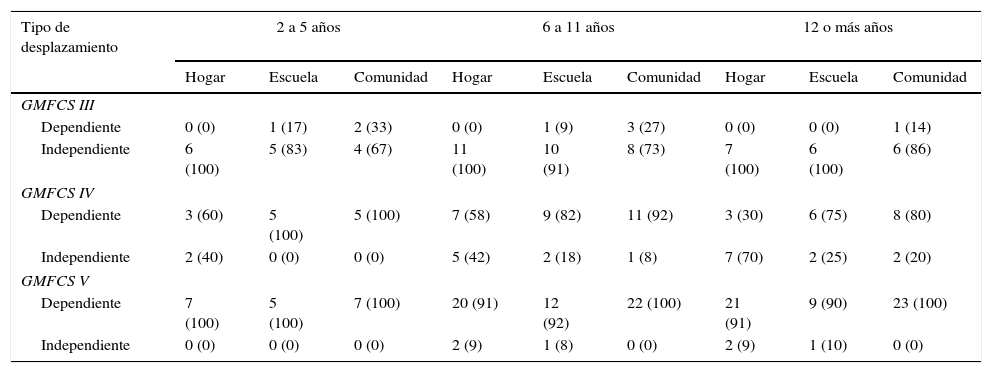Las características del hogar, escuela y comunidad tienen impacto en el uso de dispositivos y en los métodos de movilidad en niños con parálisis cerebral.
ObjetivoDescribir el número de dispositivos que poseían los pacientes, su utilización, su método de movilidad preferido en distintos ambientes y si requerían o no de la asistencia de un adulto.
MétodoEstudio descriptivo, prospectivo y analítico. Se incluyeron pacientes con parálisis cerebral de los niveles iii a v del Sistema de Clasificación de la Función Motora Gruesa (SCFMG). La información sobre el tipo de movilidad y dispositivo utilizado fue obtenida mediante cuestionario.
ResultadosSe obtuvo una muestra de 103 pacientes con un rango de 2 a 19 años (9,9±3,9); 45,6% del sexo femenino y 54,4% del masculino. En el SCFMG, 23,3% nivel iii, 26,2% nivel iv y 50,5% nivel v. El 34% cuentan con más de un dispositivo; el 83,5% cuentan con silla de ruedas; el 30,1%, con andadera; el 15,5%, con carriola, y el 2,9%, con otros dispositivos. La mayoría de los pacientes utilizan sus dispositivos de movilidad, y dicho uso se modifica acorde al ambiente. Existen diferencias significativas entre los tipos de movilidad de los pacientes en el hogar respecto a la escuela y la comunidad, ya que los niños son más independientes en el hogar comparado con los otros ambientes.
ConclusionesLa prescripción adecuada de los dispositivos para la movilidad debe considerar el ambiente, el contexto cultural, las preferencias de movilidad del paciente y su familia, así como la facilidad de adquisición.
Home, school and community characteristics have a great impact on the method and mobility devices used by children with cerebral palsy.
ObjectiveThe aim of this study was to describe the number of mobility devices owned by the patients, if the patient use them or not, their preferred mobility method in different environments and their dependence or not on adult help.
MethodThis is a descriptive, prospective and analytic study. Patients diagnosed with levels iii to v of cerebral palsy on the Gross Motor Function Classification System (GMFCS) who used a mobility device were included. Data related to the type of mobility and devices used were obtained from a questionnaire.
ResultsA study sample of 103 patients was obtained, patient age ranging from 2 to 19 years of age (9.9±3.9). A total of 45.6% were female and 54.4% male. According to the GMFCS, 23.3% of patients were in level iii, 26.2% in level iv, and 50.5% in level v. Of these, 34% owned more than one mobility device, 83.5% had wheelchairs, 30.1% walkers, 15% strollers, and 2.9% reported other devices. Most patients use their mobility devices, this use changing in regards to each environmental setting. There was a significant difference regarding mobility types in the home in regards to the school and community since the children were more independent at home compared to other settings.
ConclusionsEnvironmental setting, cultural context, mobility method preferences of patient and family and easy of availability must be considered when making an adequate prescription of any mobility device in patients with cerebral palsy.
Artículo
Si ya tiene sus datos de acceso, clique aquí.
Si olvidó su clave de acceso puede recuperarla clicando aquí y seleccionando la opción "He olvidado mi contraseña".Comprando el artículo el PDF del mismo podrá ser descargado
Precio 19,34 €
Comprar ahora












